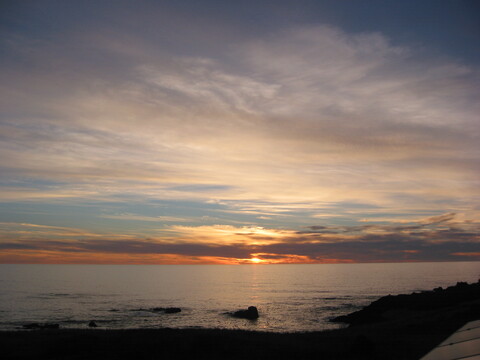
I noticed the lights of fishing boats out on the ocean. (I live on the coast of northern California.) "Hmm," I thought, "would they be out there if huge waves were on the way?" I couldn't go back to sleep, so I lay in bed watching my breath and thoughts that arose. I noticed no panic, only some planning: What should I take with me? I ran through possible necessities.
In less than a hour from the first call, a second one came. It was my husband, out of town, thinking he was the first to apprise me of the news since he checks it early on the internet and on TV. A while later, another friend, also concerned about me, called. I could have been annoyed that these kind folks had disturbed my sleep, but why? How fortunate I am that they care so much about me and my well-being.
The last call came at 7 am, from the emergency service that attends to our community. The message was that unusual waves could hit the coast at 7:30, so please do not go to any beaches or low-lying areas. There was no directive to evacuate. But I'd already packed my car and was ready to leave.
Having experienced a tsunami warning on Maui, where people still talked about the major wave that wreaked destruction on Hilo in 1946, I remembered that the main instruction is to get to higher ground. What I didn't know was whether the bluff on which our home is situated is considered high enough ground. That's why I'd packed.
Tonight, as I reflect on the morning's events, I realize how much my dharma practice kicked in. Packing became an illuminating exercise. I went straight for the things I'd thought about while still lying in bed: my laptop, several important file folders, some family papers, and a box of journals; a few items of clothing and footwear; toiletries; our dog's bowls and food; some food for me; and water.
Clearly, there were so many other things all around me, but I didn't stop for any of them. As I gathered pants and a few tops in the closet, I saw the two beautiful traditional silk jackets that Bhutanese women wear. I'd bought them on a visit to Bhutan. It never occurred to me to take them with me. Nor did I carry out any artwork, painted by others or quilted by me. And I felt no conflict about it; in fact, it didn't enter my mind at all.
Knowing that I could let go of everything (except for the few papers, journals, and laptop), left me with a sense of peacefulness. A house filled with stuff, but it didn't matter. That I didn't panic when the 5 am call came also induced a peaceful feeling. I know I wasn't that calm when the tsunami alert came on Maui more than twenty years ago. I was stuck in a slow stream of cars on the other side of the island from where all my stuff was, fretting how I'd get home in time. In the end, nothing happened, but what a job it had been to haul things to higher ground once I made it back.
When I returned home this morning after watching the ocean from higher ground--and seeing no tsunami--I unloaded the car and put things away. I thought, "Well, that was much ado about nothing. I've just wasted three and a half hours." But immediately the thinking shifted, for I realized how much I'd actually gained through the experience, and that brought a measure of joy.
I was also grateful. People in my area did not get hurt or have to flee. But when I plugged in my computer and located news about the disaster, tears welled in my eyes as I watched footage from Japan and heard about suffering on the coast as well, in Santa Cruz and Crescent City.
Sometimes we wonder whether all those retreats and daily sittings are having any effect. It's true that, sometimes, we revert to our default mode, the old patterns that got laid down when we were children. But, at other times, we have the opportunity to move beyond them, and we recognize and acknowledge that years of practice have made a difference after all. Hearing so many stories about how Munindra faced the ups and downs of his life with equanimity have inspired me to try to do the same. Today, I managed it. Read More